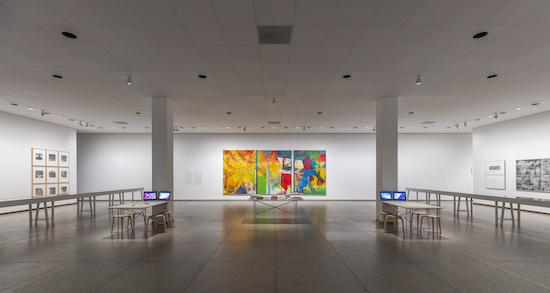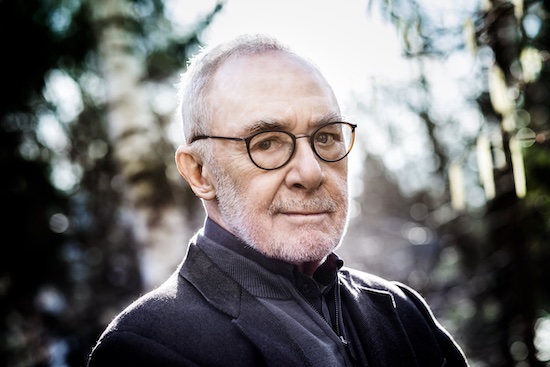Gerhard Richter, Portrait, © Werner Bartsch
Gerhard Richter is a national treasure in Germany. He’s widely regarded as an icon thanks to sixty years of artistic contributions, which makes it no surprise that institutions across his native country have gone all-out to celebrate his ninetieth birthday.
They’ve converged at Berlin’s Neue Nationalgalerie for the first major retrospective of his publications, called ‘The Artist’s Books’. But this is no overwrought gaudy love-in. Instead, it burrows into the fine print of his storied career by focusing on the artist’s prodigious printed output and lesser-seen artefacts. The results are both enlightening and accessible. And uncharacteristically, it only features a single one of Richter’s trademark colourful mammoth paintings.
The exhibition in the subterranean bowels of the newly renovated Mies van der Rohe-designed masterpiece in Potsdamer Platz packs a lot into a small space. It meticulously traces the arc of Richter’s clever and evolving work via printed texts, collages, and images. These range from early self-portraits and his first book with fellow artist Sigmar Polke in 1966, to his ambitious graphic collection of dissected and altered sections paintings from the 2012 tome Patterns.
While Richter’s large-format paintings cemented his place in the public’s imagination, this exhibition demonstrates that he’s also spent a huge amount of time and effort creating a plethora of beguiling and beautiful printed objects.
In a country that has traditionally viewed bookmaking itself as an art form, the dedication and freedom that Richter feels in creating his art books is tangible. Take his compact volume titled Eis (‘Ice’) where he chronicles his 1972 trip to Greenland in words and photographs, often flipping text and images upside down. The effect disorients and submerges the viewer in a gelid barrage of blues – either frigid sky or water.

Comic Strip, 1962, Gerhard Richter Archiv, Staatliche Kunstsammlungen Dresden, © Gerhard Richter 2022
For Richter, reproducing his works in books has allowed him to reimagine his own output. While a finished work stands as the authoritative final word, he often uses an accompanying book to re-imagine, re-present and distort the original. This practice is described by the exhibition’s curator – Michael Lailach, head of the Kunstbibliothek’s Book Art Collection – as a “game of hide-and-seek, a programmatic and at the same time protective masquerade”.
In Patterns, Richter’s game is to meticulously and repetitively isolate areas of a physical painting before digitally enlarging them, only to then reproduce them into a blurry ad nauseam. The effect is overwhelming. It takes an abstract painting from 1990 as its starting point, subdividing it in half vertically; the left half mirrored and then reassembled, only to be repeated on the double pages of the book. This procedure was then carried out using the righthand side of the image. And just for completeness, the next subdivision splits the painting into four vertical strips, producing four double page spreads that display a random kaleidoscope of ornamental patterns.
Richter describes this process by saying: “Pictures that are interpretable and that contain meaning are bad pictures. A picture presents itself as the incomprehensible, the non-logical, the nonsensical. It presents an infinite number of aspects, and deprives us of our security, because it deprives us of our own viewpoint of the object … It shows us the object in its ambiguity and endlessness, making it impossible for an opinion to even arise.”
And it’s that endlessness – specifically in Patterns or throughout the scope of his art books collected in the show – that explains why such a group effort was required to pull this one-off exhibition together. The wide-ranging collection of books, prints and ephemera are drawn from Berlin’s Kupferstichkabinett and Kunstbibliothek, the Gerhard Richter Archive at Staatliche Kunstsammlungen in Dresden, as well as The Verlag der Buchhandlung Walther und Franz König in Cologne, the publisher of almost all of Gerhard Richter’s artist’s books. And in a satisfying nod to the tactically inclined, all the books presented under glass also have companions available for visitors to examine.

Gerhard Richter. Künstlerbücher, Ausstellungsansicht, Neue Nationalgalerie 2022, © Staatliche Museen zu Berlin / David von Becker
Alongside the limited editions, preliminary designs and letters from the Staatliche Kunstsammlungen Dresden’s Gerhard Richter Archive round off the special exhibition. The sole major painting is the impressively large three-panel abstract painting Atelier from the Nationalgalerie’s own collection that essentially provides the workmanlike ‘studio’ backdrop to the cerebral show.
It also provides another examination of Richter’s obsession with depicting objects and his psychological distance as an artist. In a 1977 letter Richter writes: “I do not paint, therefore, simply to paint. I am searching for the object and the image, not for painting, but instead for our image, our appearance and standing, our viewpoint, totally and authoritatively.” That authoritative object also exists in the show – in a captivating collision of printed object and crimson pigment. It’s a limited-edition version of Richter’s War Cut catalogue with its covers and binding literally encrusted with a thick layer of the bloody red paint. It’s impossible to ignore.
Created in 1988, War Cut is regarded as one of Richter’s most controversial works of political art in its reflections on the Iraq War. The massive tome collects 165 texts about the war alongside 216 details of his abstract painting No. 648–2 from the previous year. Inside, it dissects the painting in pursuit of capturing the extreme violence and emotion of war. It’s also remarkably well-timed given Berlin’s impressive mobilisation to receive and support refugees arriving from Ukraine.
Ultimately, this exhibition is just part of the larger celebrations for Richter’s birthday which appear to be everywhere and anywhere in Germany. In his hometown of Dresden, he’s curated his own show, while in North Rhine Westphalia he’s presenting an exhibition of drawings – reportedly this is his current preferred medium. Even at age ninety, there’s no letting up for Richter and his pursuit of the ‘total’ in his art.


